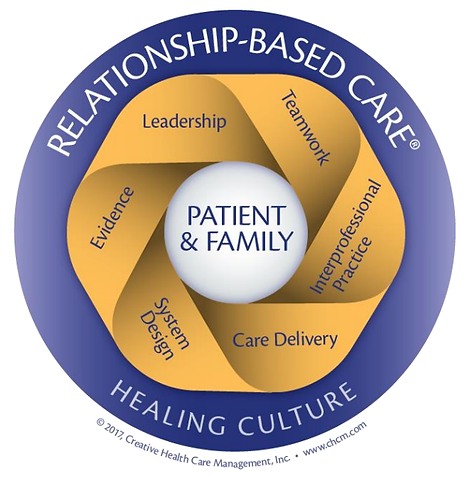
Relationship-Based Care
by Creative Healthcare Management
Grady's investment in the Relationship-Based Care (RBC) program reflects a strategic commitment to fostering a transformative and patient-centric healthcare culture. By emphasizing the principles of RBC, Grady seeks to enhance the quality of patient care, improve staff satisfaction, and create a collaborative environment that prioritizes empathy and communication. This investment is not merely a structural change but a holistic approach to cultivating a culture where the well-being of both patients and healthcare professionals is paramount. Through RBC, Grady aspires to establish enduring connections, foster resilience, and ultimately elevate the overall experience for patients and staff alike, reinforcing its commitment to excellence in healthcare delivery.
Key Relationships
How RBC Advances the Culture of Healthcare Organizations.
Care of Self:
* Self-Awareness
* Self-Management
* Self-Compassion
* Self-Care
Care of Colleagues & Team:
* Trust
* Healthy Communication
* Psychological Safety
Care of Patients & their Families:
* Relationship
* Compassion
* Dignity
* Devotion
Principles of RBC
How to bring RBC to life in Action Plans.
Caring and Healing Practice Environment:
A caring and healing environment for everyone is visible in relationships, clinical interventions, and the physical setting
Responsibility for Relationship and Decision Making:
One caregiver accepts responsibility, authority, and accountability for managing the care of specific patients. This is the primary caregiver.
Work Allocation and Patient Assignments:
The primary caregiver for each discipline as authority for determining the type of care or service a patient will receive for that specialty and who provides that care.
Connection with the Health Care Team:
The primary caregiver coordinates communication between the patient/family and other members of the interprofessional team.
Management/Leadership:
The manager creates an environment in which healthy team relationships, professional practice, and the provision of competent and compassionate care are clear expectations.
System Improvements:
Executives, managers, and staff members partner to design and continuously improve the infrastructure for optimal patient care and delivery.
Dimensions of RBC
What RBC is.
Healing Culture:
A healing culture holds all people with respect and dignity. Therapeutic relationships and a calming physical environment are core components of a healing culture.
Patient and Family:
Patients and families are at the center of all we do. Structures, processes, and relationships are developed to support each caregiver’s ability to provided attuned, compassionate, high-quality care.
Leadership:
Leadership is a quality, not a position. Leaders cultivate a shared vision, inspire and model healthy relationships, and empower people closest to the work to continuously improve their own work processes and relationships.
Teamwork:
Requires people from all disciplines to define and embrace a shared purpose and work together with trust and mutual respect.
Interprofessional Practice:
All clinical professions are respected and valued for their unique expertise and full scope of practice. Clinical practice is grounded in research.
Care Delivery:
Create systems that facilitate connection. An RBC care delivery design holds the patient and family; makes the best way the easiest way; and supports all relationships.
System Design:
Structures, processes, and relationships are continuously improved to bring quality, safety, effectiveness, and efficiency to patient care and the work environment. The perspectives of patients and the community are essential for optimizing decisions.
Evidence:
Evidence-based practice (the integration of research, clinical expertise, and what we know about the patient values) guides standards and practices throughout the organization.
